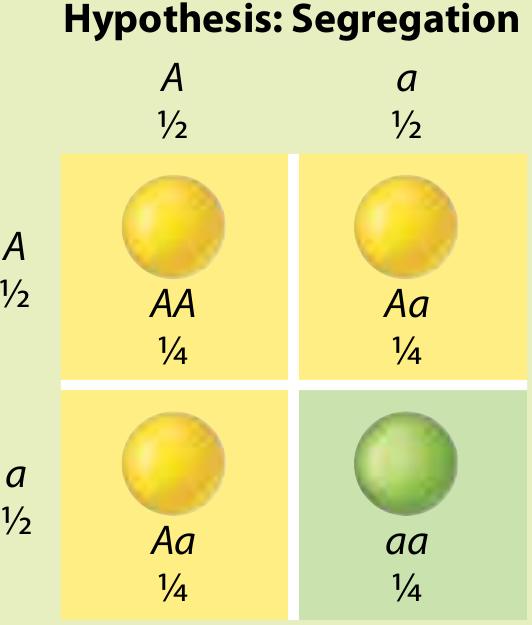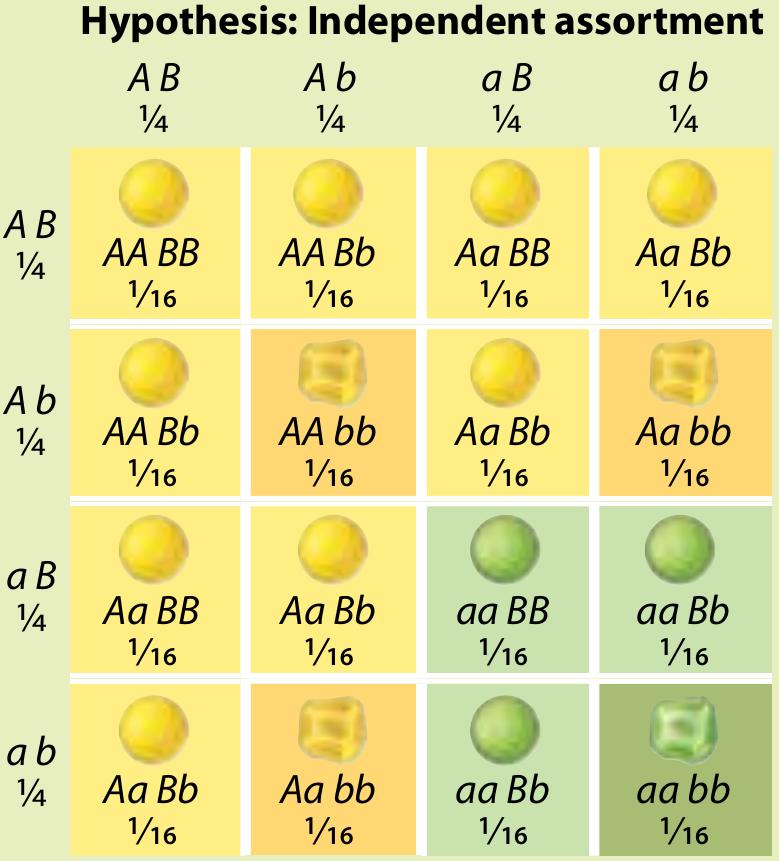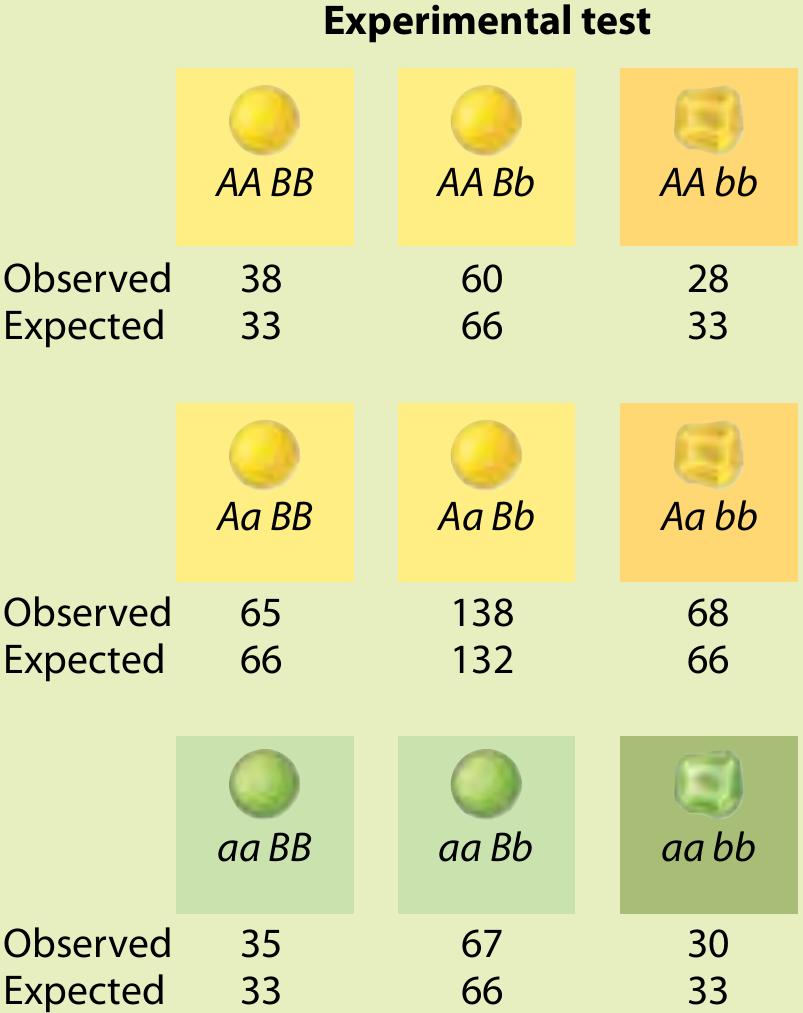Independent assortment is observed when genes segregate independently of one another.

In the cross between a strain with seeds that are yellow and wrinkled and a strain with seeds that are green and round, the phenotype of the F1 seeds is easily predicted. Because yellow is dominant to green, and round is dominant to wrinkled, the F1 seeds are expected to be yellow and round, and in fact they are (Fig. 16.12). When these seeds are grown and the F1 plants are allowed to undergo self-
| yellow round | 367 |
| green round | 122 |
| yellow wrinkled | 113 |
| green wrinkled | 37 |
The ratio of these phenotypes is 9.9:3.3:3.1:1.0, which Mendel realized is close to 9:3:3:1. The latter ratio is that expected if the A and a alleles for seed color undergo segregation and form gametes independently of the B and b alleles for seed shape. How did Mendel come to expect a 9:3:3:1 ratio of phenotypes? For seed color alone we expect a ratio of ¾ yellow : ¼ green, and for seed shape alone we expect a ratio of ¾ round : ¼ wrinkled. If the traits are independent, then we can use the multiplication rule to predict the outcomes for both traits:
| yellow round | (¾) × (¾) = 9/16 |
| green round | (¼) × (¾) = 3/16 |
| yellow wrinkled | (¾) × (¼) = 3/16 |
| green wrinkled | (¼) × (¼) = 1/16 |
Note that 9/16:3/16:3/16:1/16 is equivalent to 9:3:3:1.
The underlying reason for the 9:3:3:1 ratio of phenotypes in the F2 generation is that the alleles for yellow versus green and those for round versus wrinkled are assorted into gametes independently of each other. In other words, the hereditary transmission of either gene has no effect on the hereditary transmission of the other. A Punnett square depicting independent assortment is shown in Fig. 16.13. The A and a alleles segregate equally into gametes as ½ A:½ a, and likewise the B and b alleles segregate equally into gametes as ½ B:½ b. The result of independent assortment is that the four possible gametic types are produced in equal proportions:
| AB gametes | (½) × (½) = ¼ |
| Ab gametes | (½) × (½) = ¼ |
| aB gametes | (½) × (½) = ¼ |
| ab gametes | (½) × (½) = ¼ |

As the Punnett square in Fig. 16.13 shows, random union of these gametic types produces the expected ratio of 9 yellow round, 3 green round, 3 yellow wrinkled, and 1 green wrinkled. Fig. 16.14 summarizes how Mendel’s experiments led him to formulate his two laws.
HOW DO WE KNOW?
FIG. 16.14
How are single-
BACKGROUND Gregor Mendel’s experiments, carried out in the years 1856–
EXPERIMENTS Mendel set out to improve upon previous research in heredity. He writes that “among all the numerous experiments made, not one has been carried out to such an extent and in such a way as to make it possible to determine the number of different forms under which the offspring of the hybrids appear, or to arrange these forms with certainty according to their separate generations, or definitely to ascertain their statistical relations.” By studying simple traits across several generations of crosses, Mendel observed how these traits were inherited.
RESULTS Mendel concluded that the “statistical relations” were very clear. Crosses between plants that were hybrids of a single trait displayed two phenotypes in a ratio of 3:1. Crosses between plants that were hybrids of two traits displayed four different phenotypes in a ratio of 9:3:3:1.
HYPOTHESIS From observing these ratios among several different traits, Mendel made two key hypotheses about the inheritance of traits, now called Mendel’s laws:
1. The principle of segregation states that individuals inherit two copies (alleles) of each gene, one from the mother and one from the father, and when the individual forms reproductive cells, the two copies separate (segregate) equally in the eggs or sperm.

2. The principle of independent assortment states that the two copies of each gene segregate into gametes independently of the two copies of another gene.

ANALYSIS Mendel found support for his two hypotheses in the statistical analysis of the results of his meticulous crosses.
1. The principle of segregation: A prediction of the hypothesis of segregation is that, among seeds with the dominant phenotype, the ratio of homozygous to heterozygous genotypes should be 1:2. Mendel tested this prediction in several ways, one of which was simply to allow plants grown from F2 seeds to self-

2. The principle of independent assortment: Although the Punnett square for two pairs of alleles has 16 squares, there are only 9 genotypes, and the hypothesis of independent assortment predicts that these genotypes should appear in the ratio of 1 AA BB:2 AA Bb:1 AA bb:2 Aa BB; 4 Aa Bb:2 Aa bb:1 aa BB:2 aa Bb:1 aa bb. As before, Mendel tested this hypothesis by self-

FOLLOW-
SOURCE Mendel’s paper in English is available at http:/